Activity Based Costing for Business Improvement at Alumina Limited
VerifiedAdded on 2021/06/14
|13
|2858
|86
Report
AI Summary
This report analyzes the application of Activity-Based Costing (ABC) at Alumina Limited, an Australian company in the aluminum industry. It begins with an executive summary highlighting the need for improved cost management and decision-making to address competitive pressures and restructuring. The report then explains the features of ABC, including its focus on activities and cost drivers. It aligns ABC with Alumina Limited's mission, objectives, and corporate strategies, showing how it can enhance competitiveness and improve managerial decision-making. The report recommends training and assessment for successful implementation and suggests Time-Driven Activity-Based Costing (TDABC) as an alternative. The report emphasizes the benefits of ABC in providing accurate cost information, improving profitability, and facilitating strategic outcomes. It covers various aspects such as cost driver fitness, cost calculation accuracy, cost information credibility, and cost reporting usefulness to improve the performance of the organization.
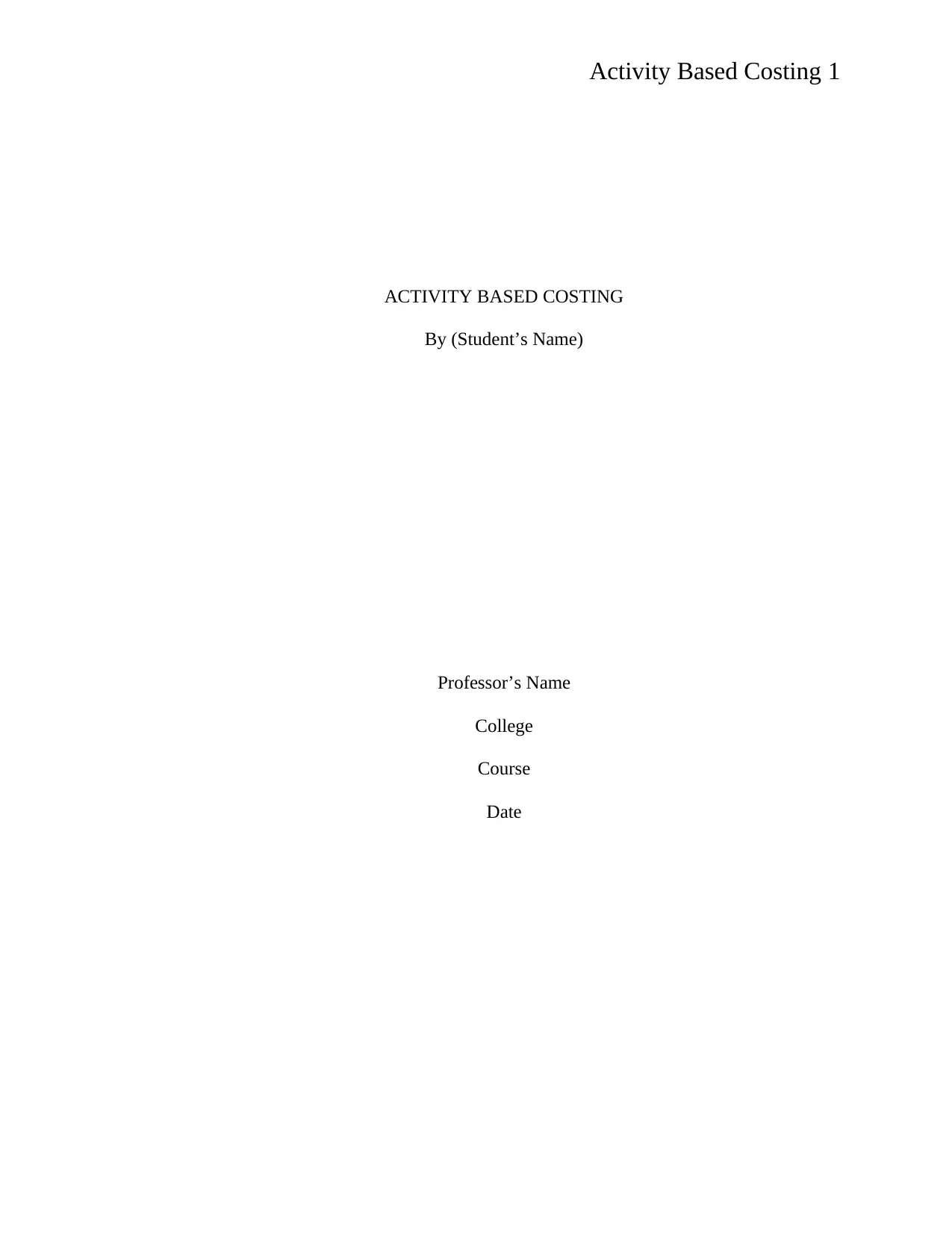
Activity Based Costing 1
ACTIVITY BASED COSTING
By (Student’s Name)
Professor’s Name
College
Course
Date
ACTIVITY BASED COSTING
By (Student’s Name)
Professor’s Name
College
Course
Date
Paraphrase This Document
Need a fresh take? Get an instant paraphrase of this document with our AI Paraphraser
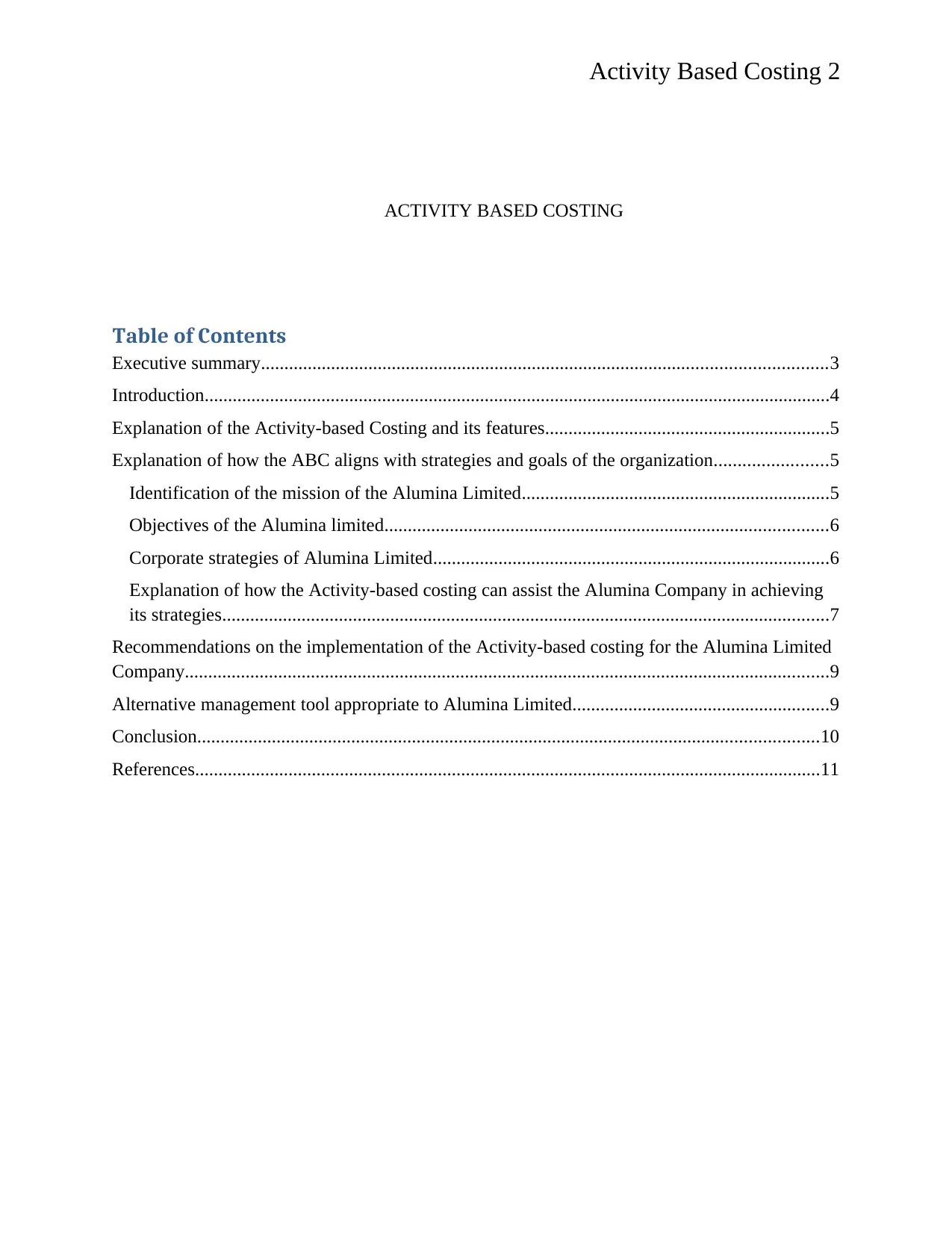
Activity Based Costing 2
ACTIVITY BASED COSTING
Table of Contents
Executive summary.........................................................................................................................3
Introduction......................................................................................................................................4
Explanation of the Activity-based Costing and its features.............................................................5
Explanation of how the ABC aligns with strategies and goals of the organization........................5
Identification of the mission of the Alumina Limited..................................................................5
Objectives of the Alumina limited...............................................................................................6
Corporate strategies of Alumina Limited.....................................................................................6
Explanation of how the Activity-based costing can assist the Alumina Company in achieving
its strategies..................................................................................................................................7
Recommendations on the implementation of the Activity-based costing for the Alumina Limited
Company..........................................................................................................................................9
Alternative management tool appropriate to Alumina Limited.......................................................9
Conclusion.....................................................................................................................................10
References......................................................................................................................................11
ACTIVITY BASED COSTING
Table of Contents
Executive summary.........................................................................................................................3
Introduction......................................................................................................................................4
Explanation of the Activity-based Costing and its features.............................................................5
Explanation of how the ABC aligns with strategies and goals of the organization........................5
Identification of the mission of the Alumina Limited..................................................................5
Objectives of the Alumina limited...............................................................................................6
Corporate strategies of Alumina Limited.....................................................................................6
Explanation of how the Activity-based costing can assist the Alumina Company in achieving
its strategies..................................................................................................................................7
Recommendations on the implementation of the Activity-based costing for the Alumina Limited
Company..........................................................................................................................................9
Alternative management tool appropriate to Alumina Limited.......................................................9
Conclusion.....................................................................................................................................10
References......................................................................................................................................11
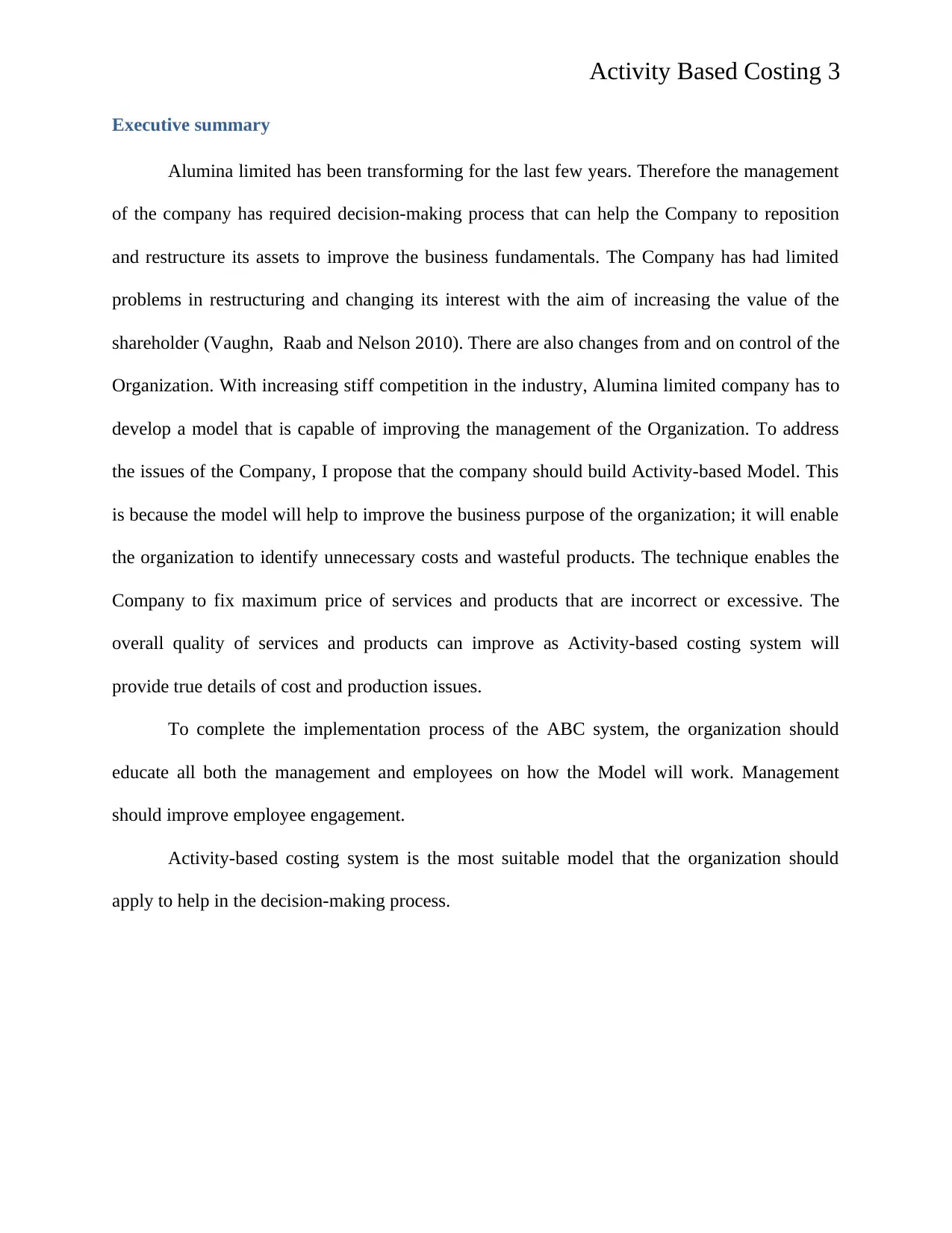
Activity Based Costing 3
Executive summary
Alumina limited has been transforming for the last few years. Therefore the management
of the company has required decision-making process that can help the Company to reposition
and restructure its assets to improve the business fundamentals. The Company has had limited
problems in restructuring and changing its interest with the aim of increasing the value of the
shareholder (Vaughn, Raab and Nelson 2010). There are also changes from and on control of the
Organization. With increasing stiff competition in the industry, Alumina limited company has to
develop a model that is capable of improving the management of the Organization. To address
the issues of the Company, I propose that the company should build Activity-based Model. This
is because the model will help to improve the business purpose of the organization; it will enable
the organization to identify unnecessary costs and wasteful products. The technique enables the
Company to fix maximum price of services and products that are incorrect or excessive. The
overall quality of services and products can improve as Activity-based costing system will
provide true details of cost and production issues.
To complete the implementation process of the ABC system, the organization should
educate all both the management and employees on how the Model will work. Management
should improve employee engagement.
Activity-based costing system is the most suitable model that the organization should
apply to help in the decision-making process.
Executive summary
Alumina limited has been transforming for the last few years. Therefore the management
of the company has required decision-making process that can help the Company to reposition
and restructure its assets to improve the business fundamentals. The Company has had limited
problems in restructuring and changing its interest with the aim of increasing the value of the
shareholder (Vaughn, Raab and Nelson 2010). There are also changes from and on control of the
Organization. With increasing stiff competition in the industry, Alumina limited company has to
develop a model that is capable of improving the management of the Organization. To address
the issues of the Company, I propose that the company should build Activity-based Model. This
is because the model will help to improve the business purpose of the organization; it will enable
the organization to identify unnecessary costs and wasteful products. The technique enables the
Company to fix maximum price of services and products that are incorrect or excessive. The
overall quality of services and products can improve as Activity-based costing system will
provide true details of cost and production issues.
To complete the implementation process of the ABC system, the organization should
educate all both the management and employees on how the Model will work. Management
should improve employee engagement.
Activity-based costing system is the most suitable model that the organization should
apply to help in the decision-making process.
⊘ This is a preview!⊘
Do you want full access?
Subscribe today to unlock all pages.

Trusted by 1+ million students worldwide
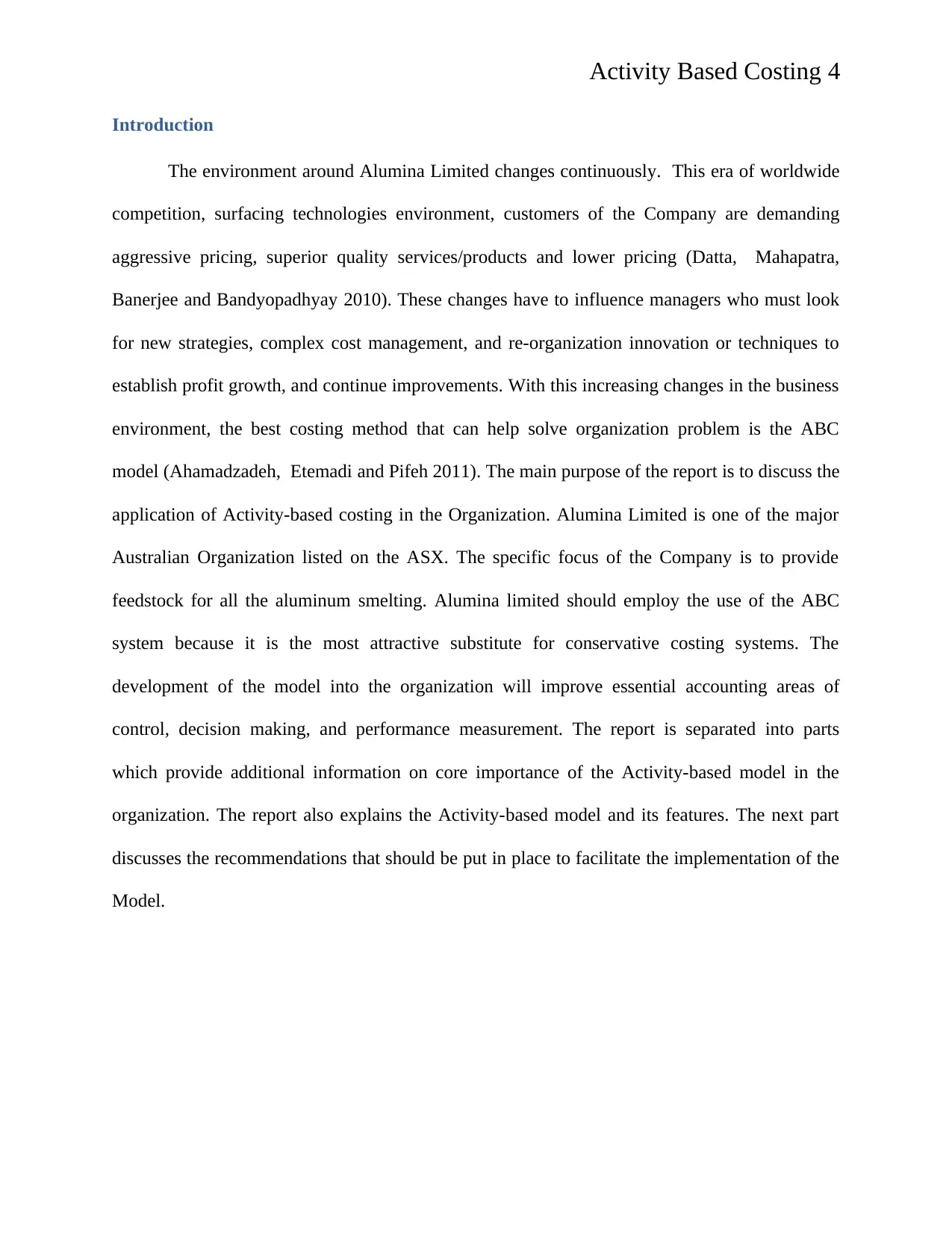
Activity Based Costing 4
Introduction
The environment around Alumina Limited changes continuously. This era of worldwide
competition, surfacing technologies environment, customers of the Company are demanding
aggressive pricing, superior quality services/products and lower pricing (Datta, Mahapatra,
Banerjee and Bandyopadhyay 2010). These changes have to influence managers who must look
for new strategies, complex cost management, and re-organization innovation or techniques to
establish profit growth, and continue improvements. With this increasing changes in the business
environment, the best costing method that can help solve organization problem is the ABC
model (Ahamadzadeh, Etemadi and Pifeh 2011). The main purpose of the report is to discuss the
application of Activity-based costing in the Organization. Alumina Limited is one of the major
Australian Organization listed on the ASX. The specific focus of the Company is to provide
feedstock for all the aluminum smelting. Alumina limited should employ the use of the ABC
system because it is the most attractive substitute for conservative costing systems. The
development of the model into the organization will improve essential accounting areas of
control, decision making, and performance measurement. The report is separated into parts
which provide additional information on core importance of the Activity-based model in the
organization. The report also explains the Activity-based model and its features. The next part
discusses the recommendations that should be put in place to facilitate the implementation of the
Model.
Introduction
The environment around Alumina Limited changes continuously. This era of worldwide
competition, surfacing technologies environment, customers of the Company are demanding
aggressive pricing, superior quality services/products and lower pricing (Datta, Mahapatra,
Banerjee and Bandyopadhyay 2010). These changes have to influence managers who must look
for new strategies, complex cost management, and re-organization innovation or techniques to
establish profit growth, and continue improvements. With this increasing changes in the business
environment, the best costing method that can help solve organization problem is the ABC
model (Ahamadzadeh, Etemadi and Pifeh 2011). The main purpose of the report is to discuss the
application of Activity-based costing in the Organization. Alumina Limited is one of the major
Australian Organization listed on the ASX. The specific focus of the Company is to provide
feedstock for all the aluminum smelting. Alumina limited should employ the use of the ABC
system because it is the most attractive substitute for conservative costing systems. The
development of the model into the organization will improve essential accounting areas of
control, decision making, and performance measurement. The report is separated into parts
which provide additional information on core importance of the Activity-based model in the
organization. The report also explains the Activity-based model and its features. The next part
discusses the recommendations that should be put in place to facilitate the implementation of the
Model.
Paraphrase This Document
Need a fresh take? Get an instant paraphrase of this document with our AI Paraphraser
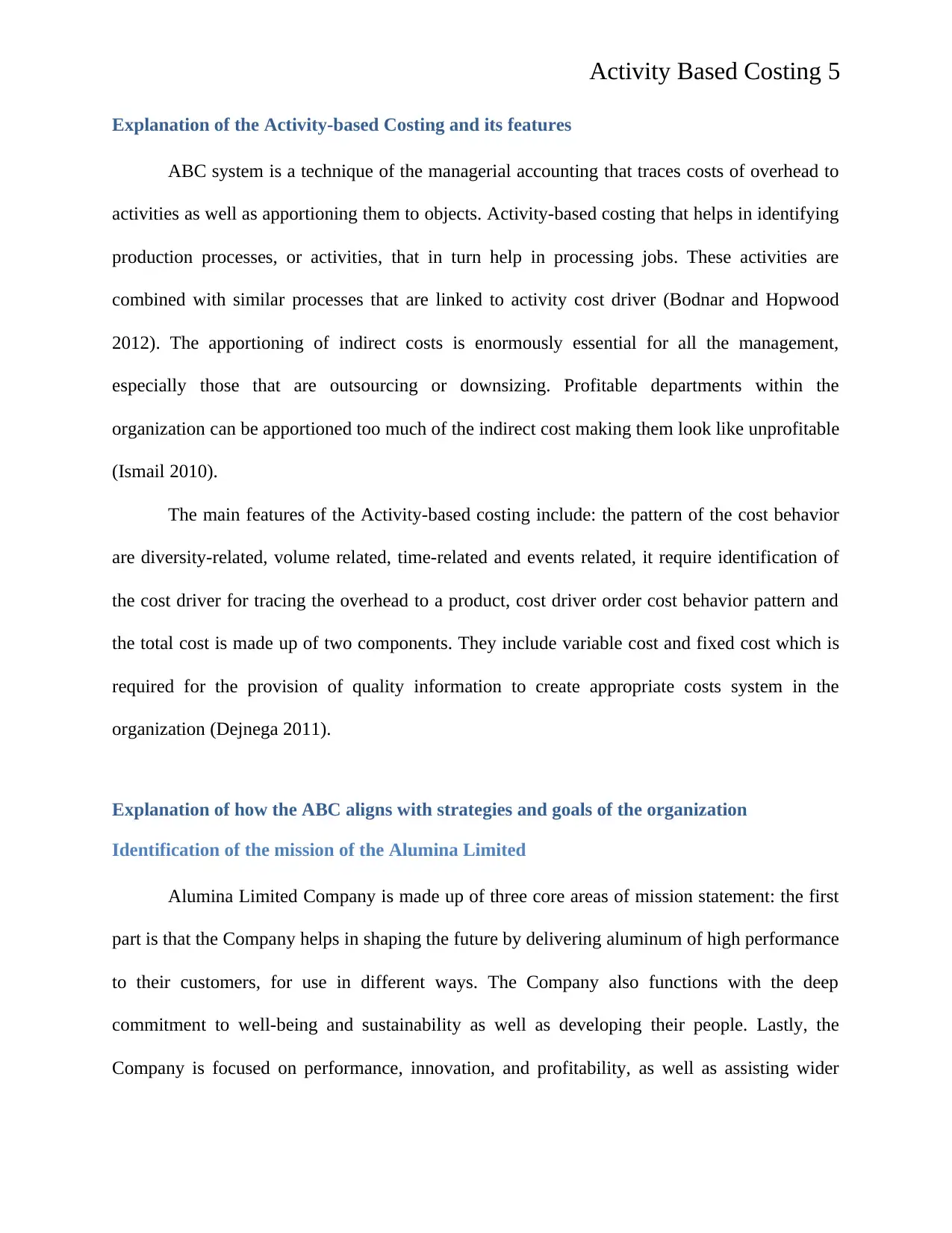
Activity Based Costing 5
Explanation of the Activity-based Costing and its features
ABC system is a technique of the managerial accounting that traces costs of overhead to
activities as well as apportioning them to objects. Activity-based costing that helps in identifying
production processes, or activities, that in turn help in processing jobs. These activities are
combined with similar processes that are linked to activity cost driver (Bodnar and Hopwood
2012). The apportioning of indirect costs is enormously essential for all the management,
especially those that are outsourcing or downsizing. Profitable departments within the
organization can be apportioned too much of the indirect cost making them look like unprofitable
(Ismail 2010).
The main features of the Activity-based costing include: the pattern of the cost behavior
are diversity-related, volume related, time-related and events related, it require identification of
the cost driver for tracing the overhead to a product, cost driver order cost behavior pattern and
the total cost is made up of two components. They include variable cost and fixed cost which is
required for the provision of quality information to create appropriate costs system in the
organization (Dejnega 2011).
Explanation of how the ABC aligns with strategies and goals of the organization
Identification of the mission of the Alumina Limited
Alumina Limited Company is made up of three core areas of mission statement: the first
part is that the Company helps in shaping the future by delivering aluminum of high performance
to their customers, for use in different ways. The Company also functions with the deep
commitment to well-being and sustainability as well as developing their people. Lastly, the
Company is focused on performance, innovation, and profitability, as well as assisting wider
Explanation of the Activity-based Costing and its features
ABC system is a technique of the managerial accounting that traces costs of overhead to
activities as well as apportioning them to objects. Activity-based costing that helps in identifying
production processes, or activities, that in turn help in processing jobs. These activities are
combined with similar processes that are linked to activity cost driver (Bodnar and Hopwood
2012). The apportioning of indirect costs is enormously essential for all the management,
especially those that are outsourcing or downsizing. Profitable departments within the
organization can be apportioned too much of the indirect cost making them look like unprofitable
(Ismail 2010).
The main features of the Activity-based costing include: the pattern of the cost behavior
are diversity-related, volume related, time-related and events related, it require identification of
the cost driver for tracing the overhead to a product, cost driver order cost behavior pattern and
the total cost is made up of two components. They include variable cost and fixed cost which is
required for the provision of quality information to create appropriate costs system in the
organization (Dejnega 2011).
Explanation of how the ABC aligns with strategies and goals of the organization
Identification of the mission of the Alumina Limited
Alumina Limited Company is made up of three core areas of mission statement: the first
part is that the Company helps in shaping the future by delivering aluminum of high performance
to their customers, for use in different ways. The Company also functions with the deep
commitment to well-being and sustainability as well as developing their people. Lastly, the
Company is focused on performance, innovation, and profitability, as well as assisting wider
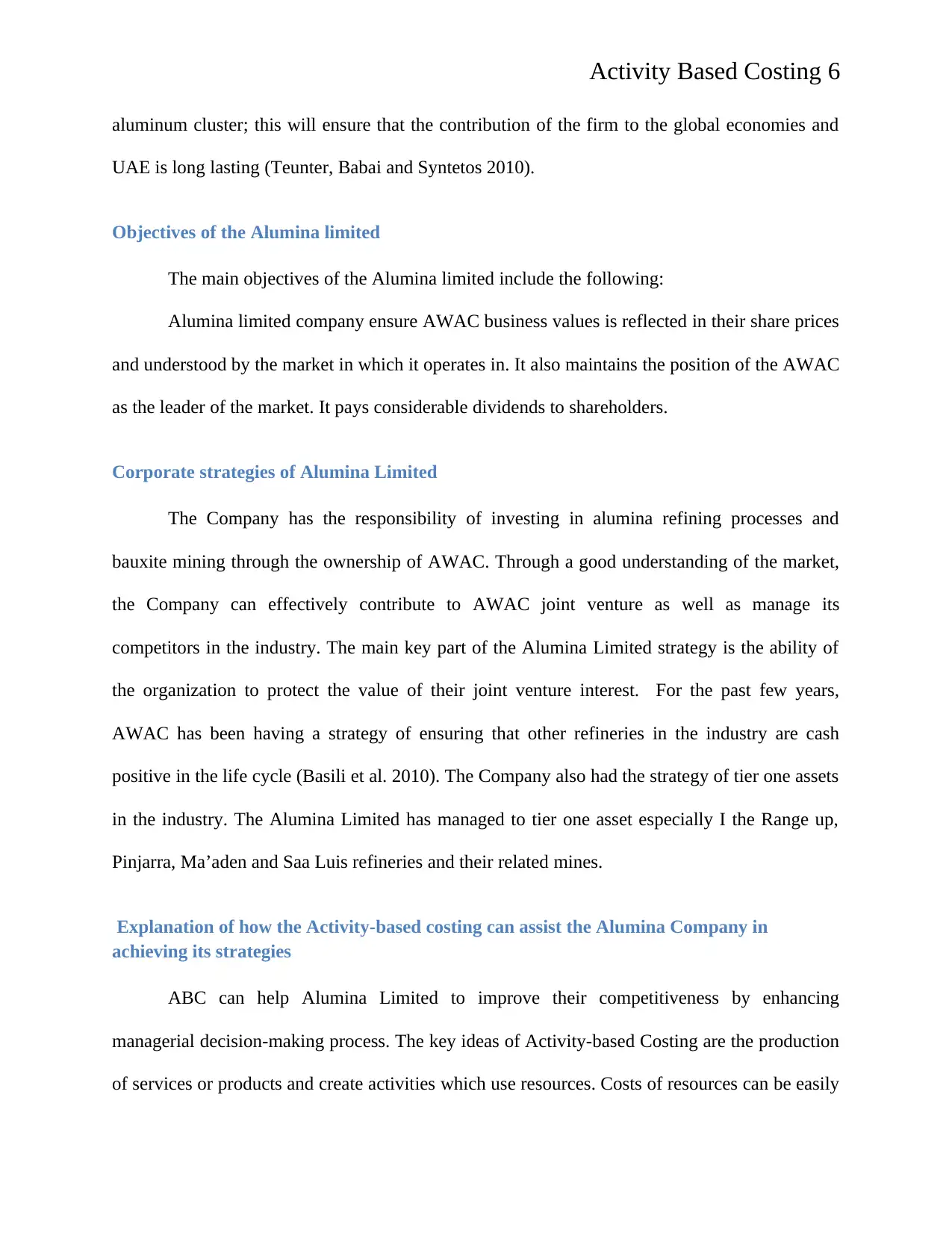
Activity Based Costing 6
aluminum cluster; this will ensure that the contribution of the firm to the global economies and
UAE is long lasting (Teunter, Babai and Syntetos 2010).
Objectives of the Alumina limited
The main objectives of the Alumina limited include the following:
Alumina limited company ensure AWAC business values is reflected in their share prices
and understood by the market in which it operates in. It also maintains the position of the AWAC
as the leader of the market. It pays considerable dividends to shareholders.
Corporate strategies of Alumina Limited
The Company has the responsibility of investing in alumina refining processes and
bauxite mining through the ownership of AWAC. Through a good understanding of the market,
the Company can effectively contribute to AWAC joint venture as well as manage its
competitors in the industry. The main key part of the Alumina Limited strategy is the ability of
the organization to protect the value of their joint venture interest. For the past few years,
AWAC has been having a strategy of ensuring that other refineries in the industry are cash
positive in the life cycle (Basili et al. 2010). The Company also had the strategy of tier one assets
in the industry. The Alumina Limited has managed to tier one asset especially I the Range up,
Pinjarra, Ma’aden and Saa Luis refineries and their related mines.
Explanation of how the Activity-based costing can assist the Alumina Company in
achieving its strategies
ABC can help Alumina Limited to improve their competitiveness by enhancing
managerial decision-making process. The key ideas of Activity-based Costing are the production
of services or products and create activities which use resources. Costs of resources can be easily
aluminum cluster; this will ensure that the contribution of the firm to the global economies and
UAE is long lasting (Teunter, Babai and Syntetos 2010).
Objectives of the Alumina limited
The main objectives of the Alumina limited include the following:
Alumina limited company ensure AWAC business values is reflected in their share prices
and understood by the market in which it operates in. It also maintains the position of the AWAC
as the leader of the market. It pays considerable dividends to shareholders.
Corporate strategies of Alumina Limited
The Company has the responsibility of investing in alumina refining processes and
bauxite mining through the ownership of AWAC. Through a good understanding of the market,
the Company can effectively contribute to AWAC joint venture as well as manage its
competitors in the industry. The main key part of the Alumina Limited strategy is the ability of
the organization to protect the value of their joint venture interest. For the past few years,
AWAC has been having a strategy of ensuring that other refineries in the industry are cash
positive in the life cycle (Basili et al. 2010). The Company also had the strategy of tier one assets
in the industry. The Alumina Limited has managed to tier one asset especially I the Range up,
Pinjarra, Ma’aden and Saa Luis refineries and their related mines.
Explanation of how the Activity-based costing can assist the Alumina Company in
achieving its strategies
ABC can help Alumina Limited to improve their competitiveness by enhancing
managerial decision-making process. The key ideas of Activity-based Costing are the production
of services or products and create activities which use resources. Costs of resources can be easily
⊘ This is a preview!⊘
Do you want full access?
Subscribe today to unlock all pages.

Trusted by 1+ million students worldwide
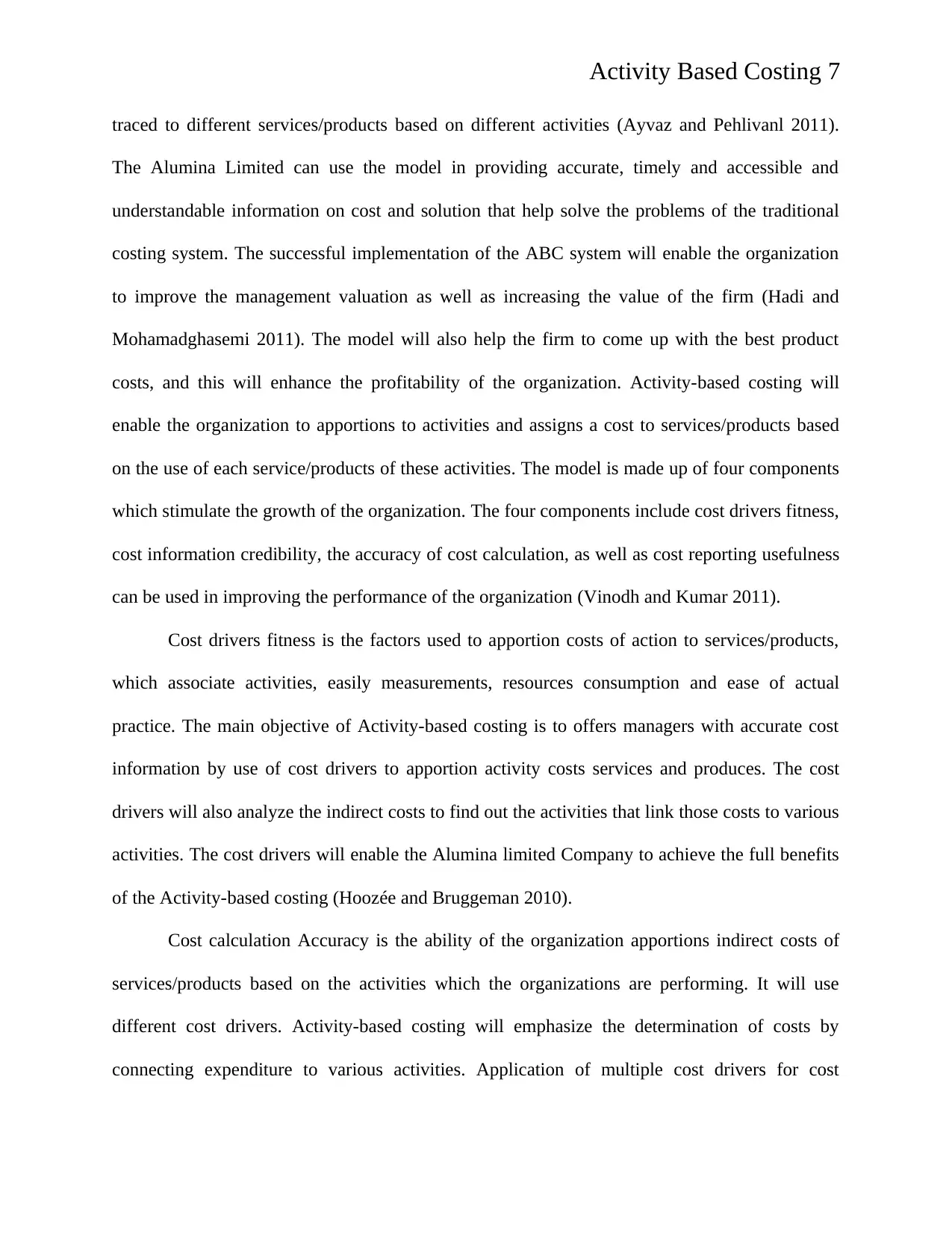
Activity Based Costing 7
traced to different services/products based on different activities (Ayvaz and Pehlivanl 2011).
The Alumina Limited can use the model in providing accurate, timely and accessible and
understandable information on cost and solution that help solve the problems of the traditional
costing system. The successful implementation of the ABC system will enable the organization
to improve the management valuation as well as increasing the value of the firm (Hadi and
Mohamadghasemi 2011). The model will also help the firm to come up with the best product
costs, and this will enhance the profitability of the organization. Activity-based costing will
enable the organization to apportions to activities and assigns a cost to services/products based
on the use of each service/products of these activities. The model is made up of four components
which stimulate the growth of the organization. The four components include cost drivers fitness,
cost information credibility, the accuracy of cost calculation, as well as cost reporting usefulness
can be used in improving the performance of the organization (Vinodh and Kumar 2011).
Cost drivers fitness is the factors used to apportion costs of action to services/products,
which associate activities, easily measurements, resources consumption and ease of actual
practice. The main objective of Activity-based costing is to offers managers with accurate cost
information by use of cost drivers to apportion activity costs services and produces. The cost
drivers will also analyze the indirect costs to find out the activities that link those costs to various
activities. The cost drivers will enable the Alumina limited Company to achieve the full benefits
of the Activity-based costing (Hoozée and Bruggeman 2010).
Cost calculation Accuracy is the ability of the organization apportions indirect costs of
services/products based on the activities which the organizations are performing. It will use
different cost drivers. Activity-based costing will emphasize the determination of costs by
connecting expenditure to various activities. Application of multiple cost drivers for cost
traced to different services/products based on different activities (Ayvaz and Pehlivanl 2011).
The Alumina Limited can use the model in providing accurate, timely and accessible and
understandable information on cost and solution that help solve the problems of the traditional
costing system. The successful implementation of the ABC system will enable the organization
to improve the management valuation as well as increasing the value of the firm (Hadi and
Mohamadghasemi 2011). The model will also help the firm to come up with the best product
costs, and this will enhance the profitability of the organization. Activity-based costing will
enable the organization to apportions to activities and assigns a cost to services/products based
on the use of each service/products of these activities. The model is made up of four components
which stimulate the growth of the organization. The four components include cost drivers fitness,
cost information credibility, the accuracy of cost calculation, as well as cost reporting usefulness
can be used in improving the performance of the organization (Vinodh and Kumar 2011).
Cost drivers fitness is the factors used to apportion costs of action to services/products,
which associate activities, easily measurements, resources consumption and ease of actual
practice. The main objective of Activity-based costing is to offers managers with accurate cost
information by use of cost drivers to apportion activity costs services and produces. The cost
drivers will also analyze the indirect costs to find out the activities that link those costs to various
activities. The cost drivers will enable the Alumina limited Company to achieve the full benefits
of the Activity-based costing (Hoozée and Bruggeman 2010).
Cost calculation Accuracy is the ability of the organization apportions indirect costs of
services/products based on the activities which the organizations are performing. It will use
different cost drivers. Activity-based costing will emphasize the determination of costs by
connecting expenditure to various activities. Application of multiple cost drivers for cost
Paraphrase This Document
Need a fresh take? Get an instant paraphrase of this document with our AI Paraphraser
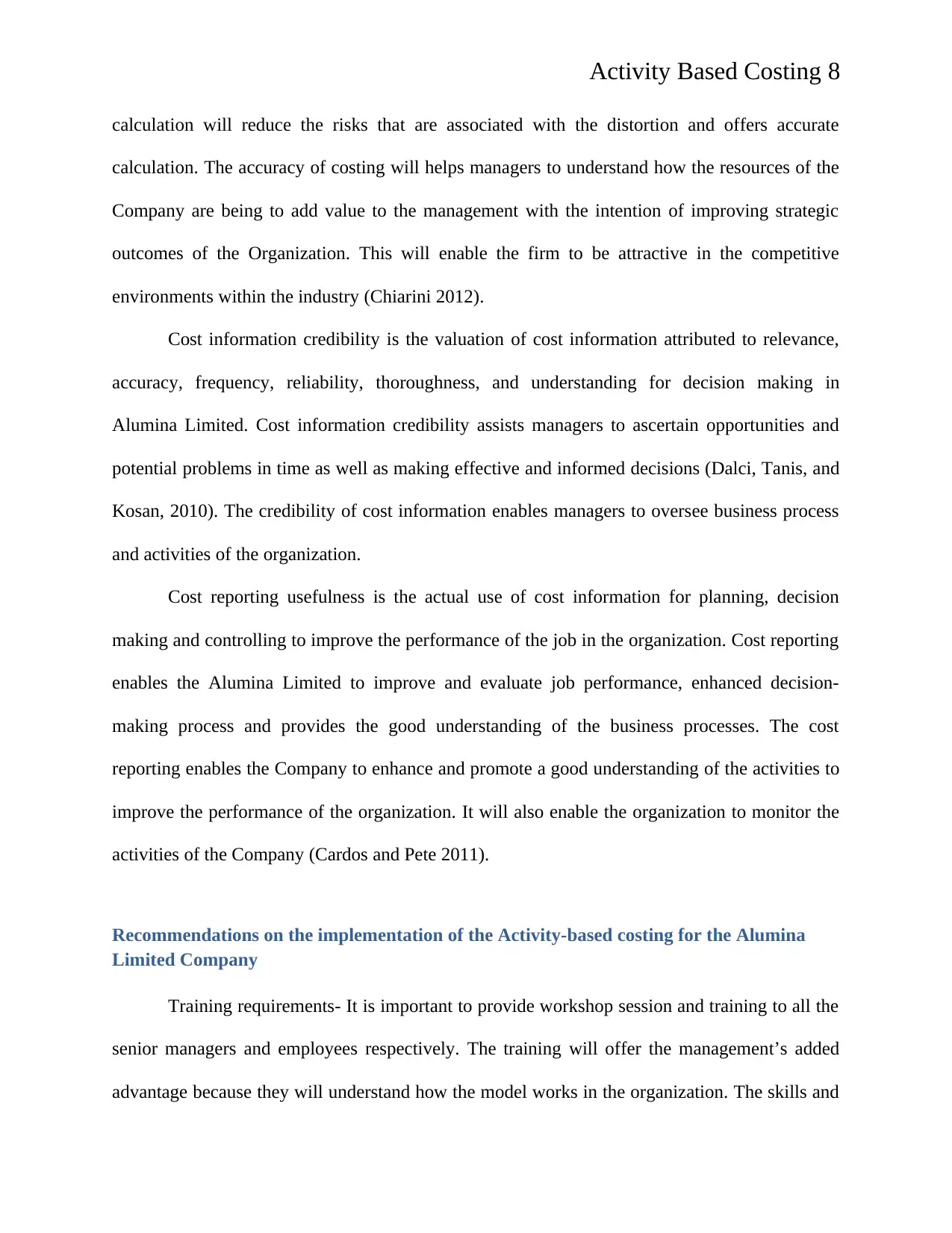
Activity Based Costing 8
calculation will reduce the risks that are associated with the distortion and offers accurate
calculation. The accuracy of costing will helps managers to understand how the resources of the
Company are being to add value to the management with the intention of improving strategic
outcomes of the Organization. This will enable the firm to be attractive in the competitive
environments within the industry (Chiarini 2012).
Cost information credibility is the valuation of cost information attributed to relevance,
accuracy, frequency, reliability, thoroughness, and understanding for decision making in
Alumina Limited. Cost information credibility assists managers to ascertain opportunities and
potential problems in time as well as making effective and informed decisions (Dalci, Tanis, and
Kosan, 2010). The credibility of cost information enables managers to oversee business process
and activities of the organization.
Cost reporting usefulness is the actual use of cost information for planning, decision
making and controlling to improve the performance of the job in the organization. Cost reporting
enables the Alumina Limited to improve and evaluate job performance, enhanced decision-
making process and provides the good understanding of the business processes. The cost
reporting enables the Company to enhance and promote a good understanding of the activities to
improve the performance of the organization. It will also enable the organization to monitor the
activities of the Company (Cardos and Pete 2011).
Recommendations on the implementation of the Activity-based costing for the Alumina
Limited Company
Training requirements- It is important to provide workshop session and training to all the
senior managers and employees respectively. The training will offer the management’s added
advantage because they will understand how the model works in the organization. The skills and
calculation will reduce the risks that are associated with the distortion and offers accurate
calculation. The accuracy of costing will helps managers to understand how the resources of the
Company are being to add value to the management with the intention of improving strategic
outcomes of the Organization. This will enable the firm to be attractive in the competitive
environments within the industry (Chiarini 2012).
Cost information credibility is the valuation of cost information attributed to relevance,
accuracy, frequency, reliability, thoroughness, and understanding for decision making in
Alumina Limited. Cost information credibility assists managers to ascertain opportunities and
potential problems in time as well as making effective and informed decisions (Dalci, Tanis, and
Kosan, 2010). The credibility of cost information enables managers to oversee business process
and activities of the organization.
Cost reporting usefulness is the actual use of cost information for planning, decision
making and controlling to improve the performance of the job in the organization. Cost reporting
enables the Alumina Limited to improve and evaluate job performance, enhanced decision-
making process and provides the good understanding of the business processes. The cost
reporting enables the Company to enhance and promote a good understanding of the activities to
improve the performance of the organization. It will also enable the organization to monitor the
activities of the Company (Cardos and Pete 2011).
Recommendations on the implementation of the Activity-based costing for the Alumina
Limited Company
Training requirements- It is important to provide workshop session and training to all the
senior managers and employees respectively. The training will offer the management’s added
advantage because they will understand how the model works in the organization. The skills and
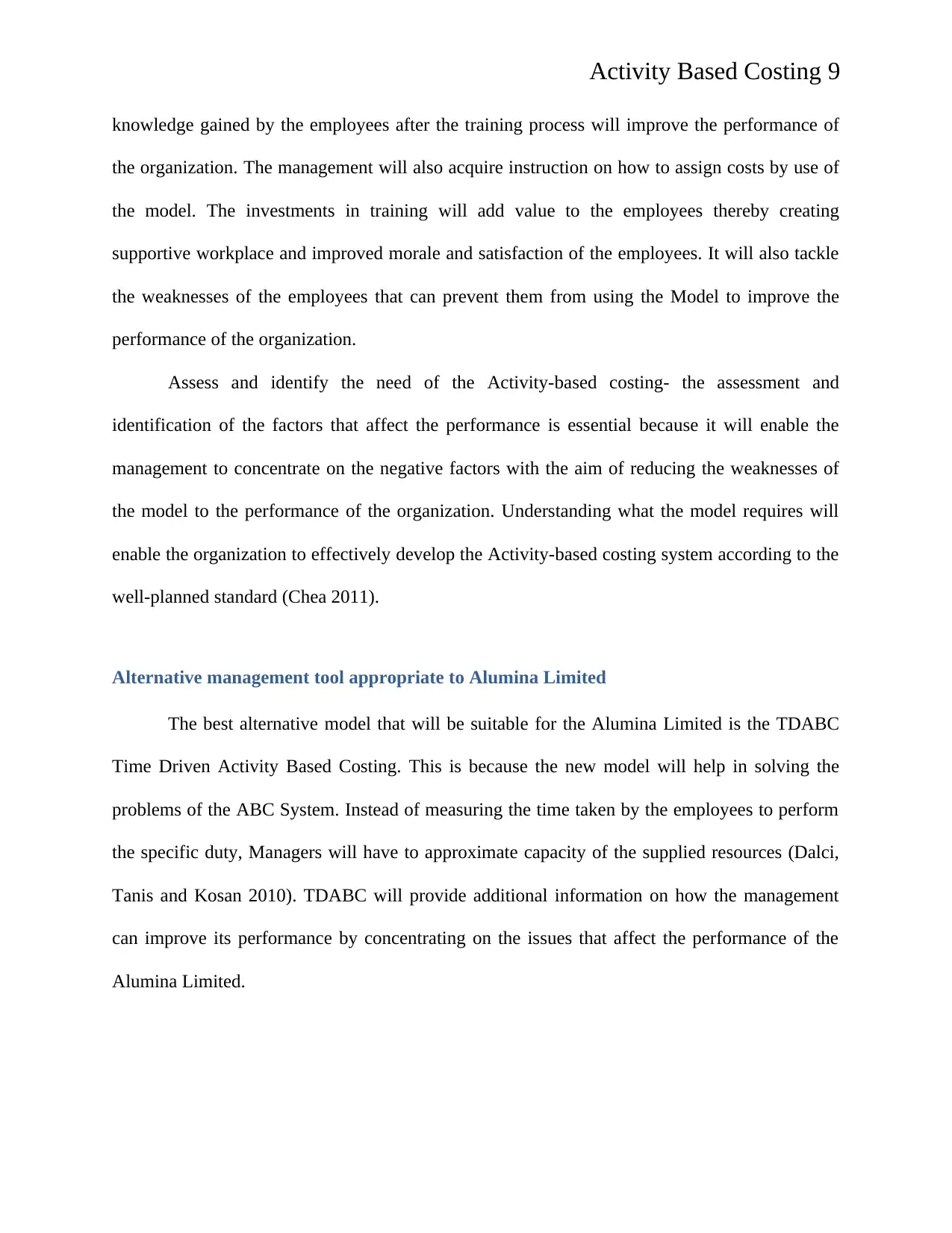
Activity Based Costing 9
knowledge gained by the employees after the training process will improve the performance of
the organization. The management will also acquire instruction on how to assign costs by use of
the model. The investments in training will add value to the employees thereby creating
supportive workplace and improved morale and satisfaction of the employees. It will also tackle
the weaknesses of the employees that can prevent them from using the Model to improve the
performance of the organization.
Assess and identify the need of the Activity-based costing- the assessment and
identification of the factors that affect the performance is essential because it will enable the
management to concentrate on the negative factors with the aim of reducing the weaknesses of
the model to the performance of the organization. Understanding what the model requires will
enable the organization to effectively develop the Activity-based costing system according to the
well-planned standard (Chea 2011).
Alternative management tool appropriate to Alumina Limited
The best alternative model that will be suitable for the Alumina Limited is the TDABC
Time Driven Activity Based Costing. This is because the new model will help in solving the
problems of the ABC System. Instead of measuring the time taken by the employees to perform
the specific duty, Managers will have to approximate capacity of the supplied resources (Dalci,
Tanis and Kosan 2010). TDABC will provide additional information on how the management
can improve its performance by concentrating on the issues that affect the performance of the
Alumina Limited.
knowledge gained by the employees after the training process will improve the performance of
the organization. The management will also acquire instruction on how to assign costs by use of
the model. The investments in training will add value to the employees thereby creating
supportive workplace and improved morale and satisfaction of the employees. It will also tackle
the weaknesses of the employees that can prevent them from using the Model to improve the
performance of the organization.
Assess and identify the need of the Activity-based costing- the assessment and
identification of the factors that affect the performance is essential because it will enable the
management to concentrate on the negative factors with the aim of reducing the weaknesses of
the model to the performance of the organization. Understanding what the model requires will
enable the organization to effectively develop the Activity-based costing system according to the
well-planned standard (Chea 2011).
Alternative management tool appropriate to Alumina Limited
The best alternative model that will be suitable for the Alumina Limited is the TDABC
Time Driven Activity Based Costing. This is because the new model will help in solving the
problems of the ABC System. Instead of measuring the time taken by the employees to perform
the specific duty, Managers will have to approximate capacity of the supplied resources (Dalci,
Tanis and Kosan 2010). TDABC will provide additional information on how the management
can improve its performance by concentrating on the issues that affect the performance of the
Alumina Limited.
⊘ This is a preview!⊘
Do you want full access?
Subscribe today to unlock all pages.

Trusted by 1+ million students worldwide
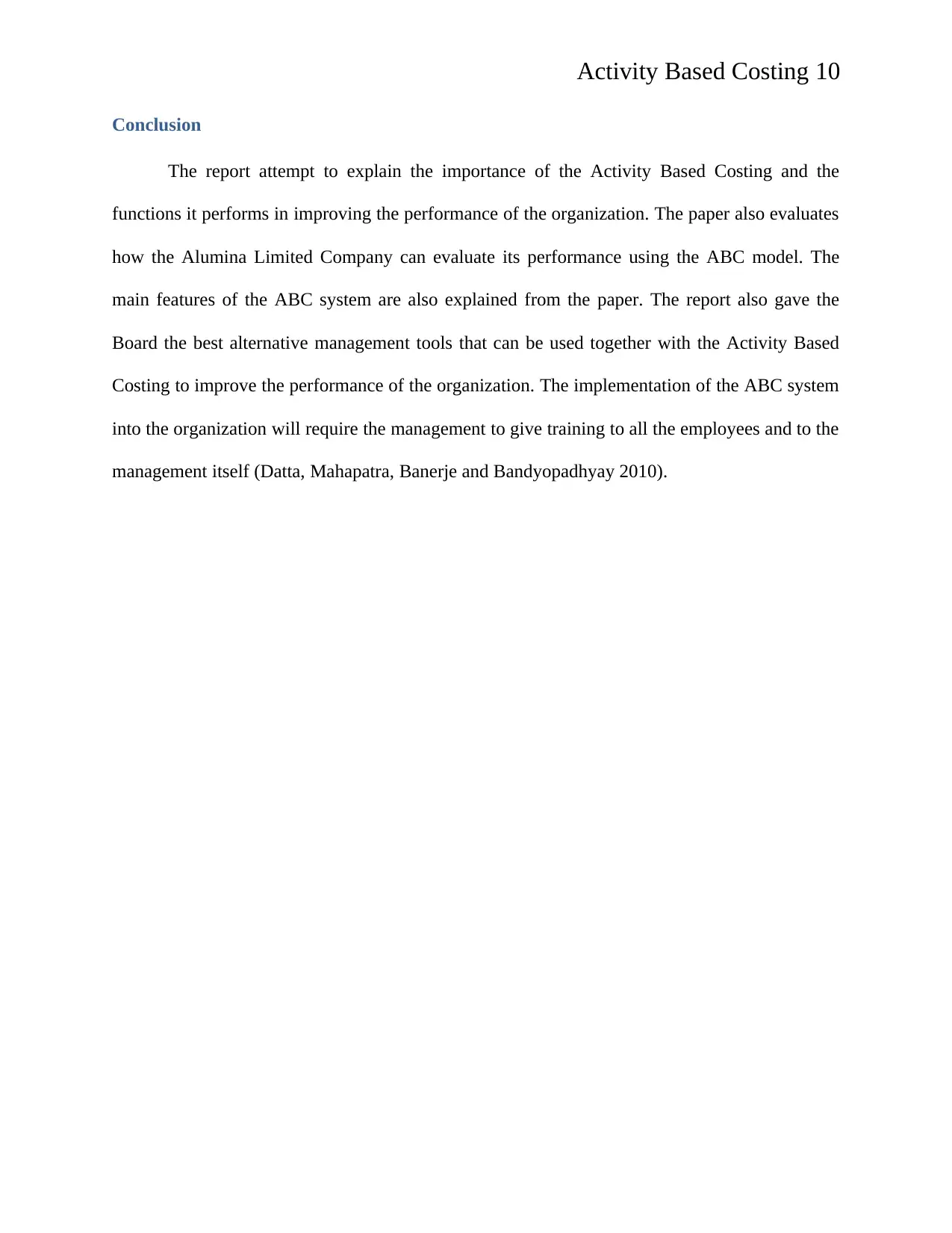
Activity Based Costing 10
Conclusion
The report attempt to explain the importance of the Activity Based Costing and the
functions it performs in improving the performance of the organization. The paper also evaluates
how the Alumina Limited Company can evaluate its performance using the ABC model. The
main features of the ABC system are also explained from the paper. The report also gave the
Board the best alternative management tools that can be used together with the Activity Based
Costing to improve the performance of the organization. The implementation of the ABC system
into the organization will require the management to give training to all the employees and to the
management itself (Datta, Mahapatra, Banerje and Bandyopadhyay 2010).
Conclusion
The report attempt to explain the importance of the Activity Based Costing and the
functions it performs in improving the performance of the organization. The paper also evaluates
how the Alumina Limited Company can evaluate its performance using the ABC model. The
main features of the ABC system are also explained from the paper. The report also gave the
Board the best alternative management tools that can be used together with the Activity Based
Costing to improve the performance of the organization. The implementation of the ABC system
into the organization will require the management to give training to all the employees and to the
management itself (Datta, Mahapatra, Banerje and Bandyopadhyay 2010).
Paraphrase This Document
Need a fresh take? Get an instant paraphrase of this document with our AI Paraphraser
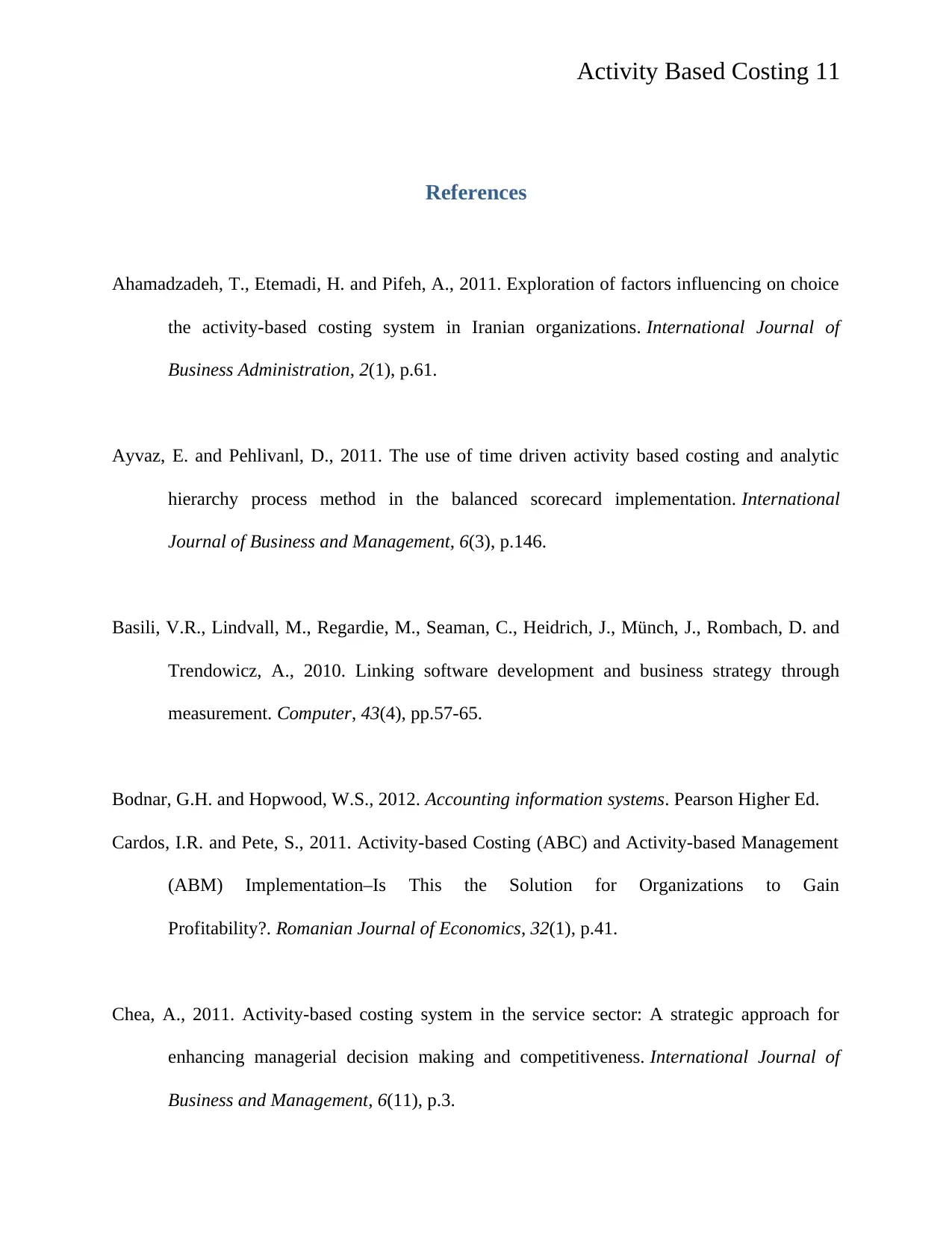
Activity Based Costing 11
References
Ahamadzadeh, T., Etemadi, H. and Pifeh, A., 2011. Exploration of factors influencing on choice
the activity-based costing system in Iranian organizations. International Journal of
Business Administration, 2(1), p.61.
Ayvaz, E. and Pehlivanl, D., 2011. The use of time driven activity based costing and analytic
hierarchy process method in the balanced scorecard implementation. International
Journal of Business and Management, 6(3), p.146.
Basili, V.R., Lindvall, M., Regardie, M., Seaman, C., Heidrich, J., Münch, J., Rombach, D. and
Trendowicz, A., 2010. Linking software development and business strategy through
measurement. Computer, 43(4), pp.57-65.
Bodnar, G.H. and Hopwood, W.S., 2012. Accounting information systems. Pearson Higher Ed.
Cardos, I.R. and Pete, S., 2011. Activity-based Costing (ABC) and Activity-based Management
(ABM) Implementation–Is This the Solution for Organizations to Gain
Profitability?. Romanian Journal of Economics, 32(1), p.41.
Chea, A., 2011. Activity-based costing system in the service sector: A strategic approach for
enhancing managerial decision making and competitiveness. International Journal of
Business and Management, 6(11), p.3.
References
Ahamadzadeh, T., Etemadi, H. and Pifeh, A., 2011. Exploration of factors influencing on choice
the activity-based costing system in Iranian organizations. International Journal of
Business Administration, 2(1), p.61.
Ayvaz, E. and Pehlivanl, D., 2011. The use of time driven activity based costing and analytic
hierarchy process method in the balanced scorecard implementation. International
Journal of Business and Management, 6(3), p.146.
Basili, V.R., Lindvall, M., Regardie, M., Seaman, C., Heidrich, J., Münch, J., Rombach, D. and
Trendowicz, A., 2010. Linking software development and business strategy through
measurement. Computer, 43(4), pp.57-65.
Bodnar, G.H. and Hopwood, W.S., 2012. Accounting information systems. Pearson Higher Ed.
Cardos, I.R. and Pete, S., 2011. Activity-based Costing (ABC) and Activity-based Management
(ABM) Implementation–Is This the Solution for Organizations to Gain
Profitability?. Romanian Journal of Economics, 32(1), p.41.
Chea, A., 2011. Activity-based costing system in the service sector: A strategic approach for
enhancing managerial decision making and competitiveness. International Journal of
Business and Management, 6(11), p.3.
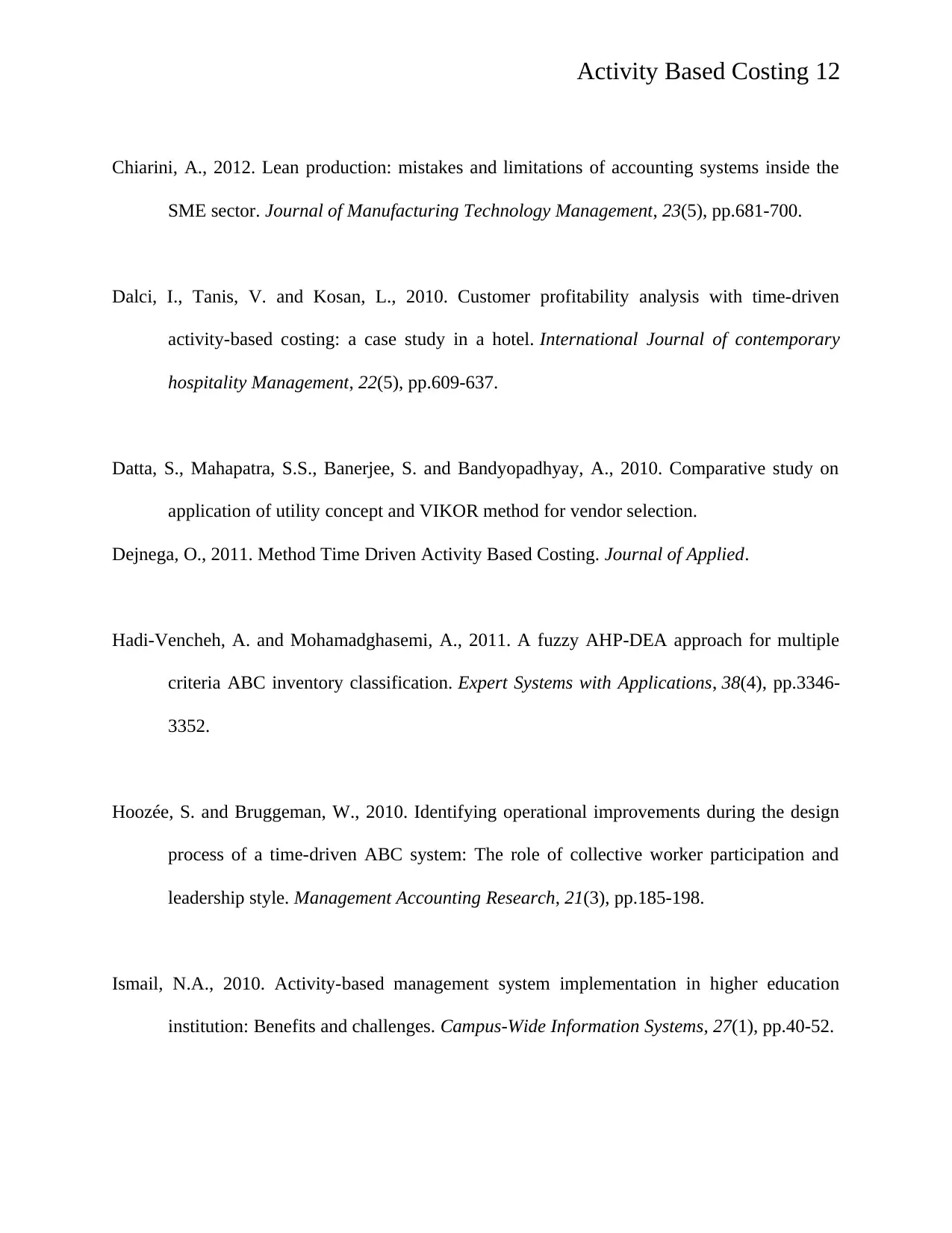
Activity Based Costing 12
Chiarini, A., 2012. Lean production: mistakes and limitations of accounting systems inside the
SME sector. Journal of Manufacturing Technology Management, 23(5), pp.681-700.
Dalci, I., Tanis, V. and Kosan, L., 2010. Customer profitability analysis with time-driven
activity-based costing: a case study in a hotel. International Journal of contemporary
hospitality Management, 22(5), pp.609-637.
Datta, S., Mahapatra, S.S., Banerjee, S. and Bandyopadhyay, A., 2010. Comparative study on
application of utility concept and VIKOR method for vendor selection.
Dejnega, O., 2011. Method Time Driven Activity Based Costing. Journal of Applied.
Hadi-Vencheh, A. and Mohamadghasemi, A., 2011. A fuzzy AHP-DEA approach for multiple
criteria ABC inventory classification. Expert Systems with Applications, 38(4), pp.3346-
3352.
Hoozée, S. and Bruggeman, W., 2010. Identifying operational improvements during the design
process of a time-driven ABC system: The role of collective worker participation and
leadership style. Management Accounting Research, 21(3), pp.185-198.
Ismail, N.A., 2010. Activity-based management system implementation in higher education
institution: Benefits and challenges. Campus-Wide Information Systems, 27(1), pp.40-52.
Chiarini, A., 2012. Lean production: mistakes and limitations of accounting systems inside the
SME sector. Journal of Manufacturing Technology Management, 23(5), pp.681-700.
Dalci, I., Tanis, V. and Kosan, L., 2010. Customer profitability analysis with time-driven
activity-based costing: a case study in a hotel. International Journal of contemporary
hospitality Management, 22(5), pp.609-637.
Datta, S., Mahapatra, S.S., Banerjee, S. and Bandyopadhyay, A., 2010. Comparative study on
application of utility concept and VIKOR method for vendor selection.
Dejnega, O., 2011. Method Time Driven Activity Based Costing. Journal of Applied.
Hadi-Vencheh, A. and Mohamadghasemi, A., 2011. A fuzzy AHP-DEA approach for multiple
criteria ABC inventory classification. Expert Systems with Applications, 38(4), pp.3346-
3352.
Hoozée, S. and Bruggeman, W., 2010. Identifying operational improvements during the design
process of a time-driven ABC system: The role of collective worker participation and
leadership style. Management Accounting Research, 21(3), pp.185-198.
Ismail, N.A., 2010. Activity-based management system implementation in higher education
institution: Benefits and challenges. Campus-Wide Information Systems, 27(1), pp.40-52.
⊘ This is a preview!⊘
Do you want full access?
Subscribe today to unlock all pages.

Trusted by 1+ million students worldwide
1 out of 13
Related Documents
Your All-in-One AI-Powered Toolkit for Academic Success.
+13062052269
info@desklib.com
Available 24*7 on WhatsApp / Email
![[object Object]](/_next/static/media/star-bottom.7253800d.svg)
Unlock your academic potential
Copyright © 2020–2025 A2Z Services. All Rights Reserved. Developed and managed by ZUCOL.





